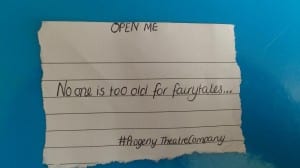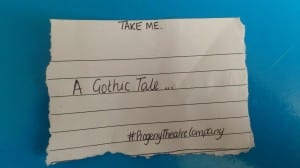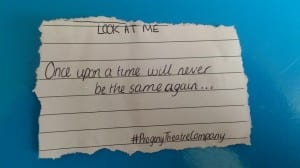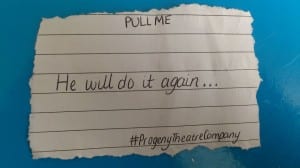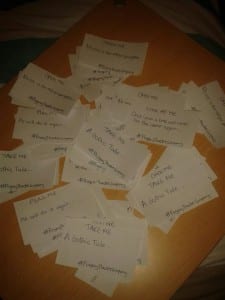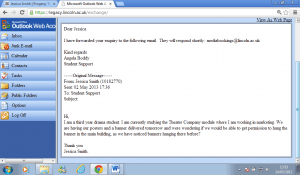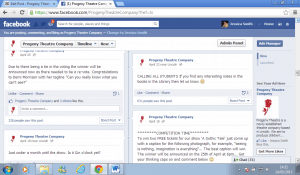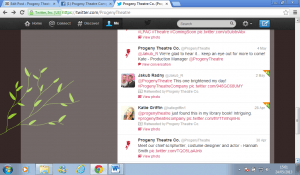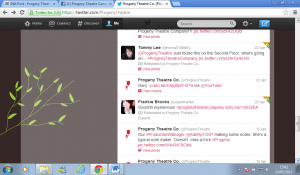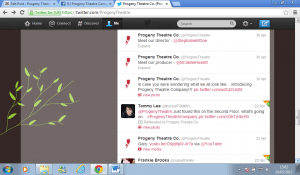What do we mean when we say ‘Children’s theatre for adults’?
I have been considering carefully what we truly mean when we say children’s theatre for adults and how exactly one would go about directing such a concept. I first considered our audience and then the perception of contemporary theatre as a whole.
I recently read an article from the guardian website titled ‘A grown up attitude to children’s theatre – and not a fairy tale in sight.’ Although the main focus of the article is aimed at representation of children’s theatre and the exploration of it, I found myself thinking about what I aimed to achieve in Progeny Theatres production, an essential reverse of children’s theatre. Although I agree with what David Harradine’s has to say about the experimental new wave of children’s theatre being exploited out there, I do disagree with his expectations of audience.
Given the extraordinary ways in which children engage with performance, it’s also surprising that there isn’t more of this already. I’ve always revelled in the freedom that comes with making work for children. When you’re making a show for, say, a three-year-old, you know that person doesn’t know – and doesn’t care – what “theatre” is. Unlike adult audiences, children come with no expectation of what they’re about to see.[1]
I disagree here with Harradine’s narrowing of audiences imaginations, he seems to claim that children are the only audience that come with no expectation – that it is impossible to surprise an audience. As a director, I want to create something unexpected and exciting, which is where Progeny Theatres concept of children’s theatre for adults was born. I can see why Harradine has got this opinion of children’s perception of theatre from and to an extent I agree with the freedom of thought children come to the theatre with however, I believe this is something we can recapture within in the adult audience. I ultimately believe this is one of the fundamental reasons we all visit the theatre, to recapture a feeling or experience the new and the unknown. The ‘expectation’ that Harradine talks of here is almost in a negative light, but new age contemporary audiences are not always seeking to watch a production full of confusion and philosophical insight.
I have aimed to produce a piece of theatre that like child audiences, the adult audience will come with no expectation of what they’re about to see, or even if they do – the expectation will never be met. It is almost a piece about expectation, about what we expect from the theatre, I aim to have the audience asking the wrong questions. I want them to feel uncomfortable at how much expectation they place on themselves when they come to the theatre. In this high spectacle I have created two worlds to feed a liminal space that the audience feel caught between. The fairy tale elements will hopefully take them back to a memory of child hood and the feeling of freedom that they no longer associate with the theatre. I believe this feeling is never lost, rather they have been told this cannot be recreated in such articles such as Harradine’s. This is why I have incorporated the abrupt, corrupt nature of our play with huge stark contrasts, the audience almost are emerged in a confusion between what is heart breaking, humorous, imaginary and real. I hope to have mixed reactions from the audience in our production, some people feeling uncomfortable, others laughing at moments they feel they should perhaps not be and a wanting for empathy that never comes from a production such as A Gothic Tale.
I read another article asking the question ‘How far should theatre push us?’ by Maddy Costa and she brought up some interesting points about the type of experience audiences can take and whether or not the theatre should be pushing the boundaries of their audience more. She remarks on a company at the in between time festival in Bristol,
What Cole and her team understand exceptionally well is the need to challenge audiences – whether with work of quiet fragility, or work that is aggressive and contradictory. More than that, they understand that challenging art needs protection: the fragile, to ensure that its voice can be heard in the push towards art that is easier to consume; the aggressive, because it antagonises social boundaries and questions the limits otherwise placed on freedom and imagination.[2]
I agree here with the expectation and the need to challenge audiences through performing arts. The idea of antagonising ‘social boundaries’ and questioning the limits placed on ‘freedom and imagination’, I feel that although new age shocking theatre is becoming more acceptable and almost expected, it is something that can be created in even the most ‘fragile’ performances. This is how I vision A Gothic Tale coming together, Costa’s description of a ‘quiet fragility’ is what is hidden in the soul of our high tech production. It is contradictory and at some points aggressive, but it is the subtle message, the irony and the limits and boundaries we have created and also destroyed for our audience that will make this piece of theatre a unique, uncomfortable and thrilling experience.
As a director, I have even tried to recreate this in the rehearsal environment among actors, taking them from a dark, sexual and graphic scene straight into a fairy tale dance number that makes them feel uncomfortable.
[1] Harradine, David. . (2009 ). A grown up attitude to childrens theatre – and not a fairytale in sight. . Available: http://www.guardian.co.uk/stage/theatreblog/2009/nov/30/childrens-theatre-christmas. Last accessed 28/04/2013
[2] Costa, Maddy.. (2013). How far should theatre push us?. Available: http://www.guardian.co.uk/stage/theatreblog/2013/feb/20/how-far-should-theatre-push-us. Last accessed 28/04/2013.
